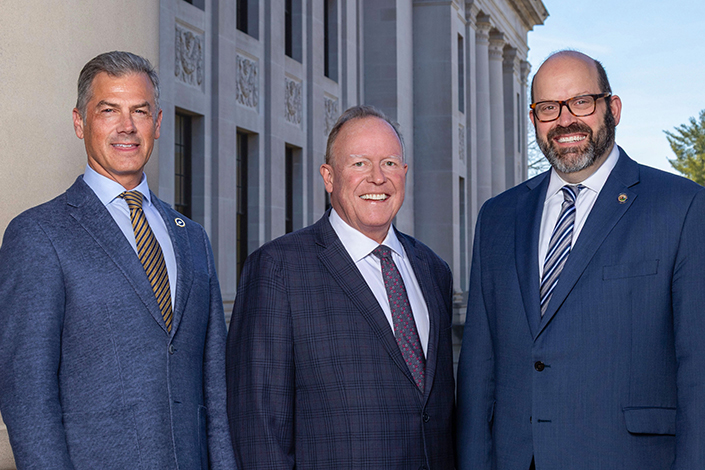By Heather Williams
The basics of today’s education system—technology, policy, curriculum—are constantly changing. A solid education is a must-have tool for success, and the continual integration of technology into the school system is the key to preparing students for an increasingly competitive global market. For the 2012 Education Issue, West Virginia Executive asked members of the state’s education, government and business sectors to share what they have identified as the challenges West Virginia’s education system is currently facing. A challenge was only the first part of our request, however; we also asked them to provide a solution to the challenge—suggestions that may provide a jump-start to the conversations that will lead to positive change for our students and teachers.
 Josh Stowers
Josh Stowers
Member, West Virginia House of Delegates
Alum Creek, WV
Challenge: Meeting the 21st century’s global marketplace demands for a high quality work force in order to grow West Virginia’s economy.
Solution: West Virginia must invest in a career/technical path at the middle school level. Reconnecting students through a viable vocational program is critical in stemming West Virginia’s dropout epidemic while providing the state’s employers with a high quality work force. While this effort is currently minimal, data illustrates that most students decide to drop out well before high school. Reconnecting high-risk students with the relevance of school through the development of a marketable skill will better provide for their future and West Virginia’s economy.
 Jim Martin
Jim Martin
President and CEO, Citynet
Bridgeport, WV
Challenge: Utilizing technology properly to allow our youth to have the same educational opportunities as those in our surrounding states.
Solution: Across the nation, millions of educational institutions and households are receiving 20, 50 and 100 megabit (Mb) broadband Internet service. In West Virginia, however, we struggle to attain the Federal Communications Commission’s current definition of 5 Mb of service in our homes and schools. The current technologies being used in West Virginia have significant performance limitations that can only provide up to 3 Mb of service in most locations. To provide our youth with the same educational opportunities as those around the nation, the State of West Virginia must implement progressive broadband policies to help overcome the current limitations caused by our existing infrastructure.
 Patricia Kusimo, Ph.D.
Patricia Kusimo, Ph.D.
President and CEO, The Education Alliance
Charleston, WV
Challenge: Increasing West Virginia’s high school completion rate while ensuring graduates have the competencies needed to succeed in a career or education after high school.
Solution: Research consistently shows that third grade reading proficiency is a good predictor of success in high school completion. West Virginia’s 2011 third grade reading scores indicate only 46 percent of all students were reading at or above grade level and only 35 percent of low-income students were reading at or above the third grade level. More students can meet the third grade benchmark if their pre-K through third grade reading instruction is consistently high quality. Students need to be given adequate time each year in pre-K through third grade—a minimum of 180 days—to master critical reading skills, and community members, especially guardians and/or parents, must promote and model reading for information and fun.
 Gary Clay
Gary Clay
Chairman, West Virginia Manufacturer’s Association Education and Workforce Development Committee
Elkins, WV
Challenge: Addressing the fact that more than 70 percent of our students either drop out of high school or graduate with a high school degree and don’t graduate from college.
Solution: The business and education sectors need to work together to identify where the jobs are today and will be in the future. This partnership should also determine which skill sets should be taught to prepare our students for these opportunities and set up career paths for students to follow. A statewide marketing plan would inform politicians, parents, teachers, business leaders and, most importantly, students about these careers and how we can prepare our children for the future.
 Danielle Dolin-Bane, Ph.D.
Danielle Dolin-Bane, Ph.D.
Director, Extended Learning Organizational MA Program, WVU
Fairmont, WV
Challenge: Preparing college graduates to effectively use both face-to-face and technological interaction for career success.
Solution: Employers are clamoring for individuals who command the technology at their fingertips and who successfully converse with others face-to-face (F2F). Workforce West Virginia projections are filled with communication skills, abilities and knowledge areas that are expected to be in high demand by 2018. Historically, technology relentlessly forges ahead despite other forces. Higher education must help students weave the two together. Graduates will need to demonstrate F2F skills in interviews and group problem-solving in their workplaces while demonstrating mastery of progressive technology to assist them in these processes. This means equipping every higher education classroom with cutting-edge technology and preparing professors to integrate it into their F2F classrooms.
 Chad Barnett
Chad Barnett
Headmaster, The Linsly School
Wheeling, WV
Challenge: Determining what place tradition should hold in 21st century schools.
Solution: As the headmaster at an independent school founded nearly 200 years ago, I worry that in the scramble to articulate what schools can do for children in the fluctuating 21st century climate, we could talk ourselves out of holding on to the good ideas that got us this far. This means that we need to understand that founding educational principles matter as much today as they did in 1814. Technology and instructional tactics have evolved during the past two centuries, yet perseverance and resilience remain core values in preparing adolescents to thrive in an increasingly complicated world.
 Dana Waldo
Dana Waldo
Senior Vice President and General Manager—West Virginia, Frontier Communications
Charleston, WV
Challenge: Affecting a revolutionary transformation of American education through technology.
Solution: Technology brings to the educational experience new opportunities for teachers and students to access the resources they need when and where they are needed. Distance instruction, collaborative engagement, online research and other forms of digital learning drastically depart from traditional classroom models. Consequently, the technology-savvy teacher of the future will depart from traditional instruction in which students segregated into same-age groups receive the same content at the same pace. The teacher of the future will possess the skills to harness the power of technology. We must include the role of new technologies in future pedagogy curriculum, and we must provide current educators the training for new technologies for the benefit of their students.
William Alderman
Program Coordinator for Mine Management, Southern WV Community and Technical College
Mount Gay, WV
CHALLENGE: Encouraging a continued interest for career choices in mining-related fields despite the economic uncertainty and longevity issues due to anti-coal and anti-energy related technologies.
SOLUTION: A combination of significant mining-related college degree programs and sponsorships by major energy companies would create continued interest in mining-related career choices. This core of education and experience would provide a competitive edge to an industry competing globally and domestically. Our energy resources can be more efficiently and conscientiously mined, resulting in the integration of sustainable development principles and ethical responsibilities into students’ problem solving, design and decision making abilities. We must strike a balance between our environment and our economy that creates and maintains these jobs while protecting and developing the environment as part of the process.
 Barry Holstein
Barry Holstein
Member, Providence Business Consultants
Cross Lanes, WV
CHALLENGE: Creating flexibility in education and responsiveness to the rapid change of global communication and its resulting technological advances.
SOLUTION: To keep pace with the changing world, we must quickly abandon the education model in which students follow a rigid curriculum of going to a classroom to be taught by a local instructor who may not be a subject expert. In a world of global communication, it is unconscionable that children in the United States are needlessly limited in educational opportunities because of geographic location or teacher availability. To accomplish this, we must look at alternative education funding models. A voucher program would allow a student to work from any computer, sign up and pay for an endless array of course work and be educated by subject matter experts from anywhere in the country. Colleges have done this successfully, and it is time to move this to the secondary education level. West Virginia could be a leader in the nation and turn our costly brick and mortar classrooms into virtual classrooms, teaching children all over the country.
 Gregory Bailey
Gregory Bailey
Partner, Bowles, Rice, McDavid, Graff & Love, PLLC
Morgantown, WV
CHALLENGE: Allowing teachers and school administrators to focus on student achievement.
SOLUTION: Public education in West Virginia is a highly regulated endeavor. The pressure to prepare our students to become competitive globally leads to a steady stream of well-meaning laws and policies that must be absorbed and implemented by our teachers and administrators. Too often, resources needed to provide high quality education in the classrooms are diverted to give attention to the latest wave of regulation. A meaningful check up on any new statute or policy could be achieved if an estimate of the time to be devoted to tasks secondary to classroom instruction and administrator support for curriculum and instruction was undertaken. Only then could an informed decision be made upon the true benefits of any proposed regulatory requirement.

Tim McClung
Account Executive, Wells Fargo Insurance Services of WV, Inc.
Charleston, WV
CHALLENGE: Addressing the claim by some high school students that school is boring, irrelevant and disconnected from real life by giving them a real-life experience.
SOLUTION: We need to connect school life to real life by doing things differently. For instance, instead of teachers, each student should have an advisor who signs a multi-year commitment to serve as that student’s coach or mentor and guides the student in managing his or her personalized learning plan. Grades would be replaced by authentic assessments such as public exhibitions of work, reflective journals, portfolios and feedback from the student’s real-world mentors at work. Instead of requiring that all learning occur while locked inside the school building, students would spend two days a week pursuing their interests and/or passions with their mentors for in-school credit. Students would also be encouraged to take a leadership role in their school, and the students’ voices would be valued in decision making processes in place of administrative school policies being handed down.
 Frank Devono, Ed.D.
Frank Devono, Ed.D.
Superintendent, Monongalia County Schools
Morgantown, WV
CHALLENGE: Providing the highest quality public education possible for all of West Virginia’s students.
SOLUTION: Comprehensive, relevant and ongoing staff development will enable our state’s professional education staff to employ effective research-based educational strategies at all programmatic levels. Through both dedicated instructional sessions and the assignment of on-site technology integration specialists, staff development can empower our teachers to utilize technological advances and Web-based resources as they help their students achieve content standards and objectives. Teaching coaches can collaborate with teachers in their classrooms to reinforce staff development content, from disaggregating students’ test scores to implementing appropriate personalized instruction for students requiring additional assistance. Additionally, well-conceived and presented staff development can reenergize veteran staff by engaging them in 21st century instructional strategies.
 Bob Dunkerley
Bob Dunkerley
President and CEO, Helianthus LLC
Elkins, WV
CHALLENGE: Implementing and sustaining a 21st century-oriented public schooling system that engages all the stakeholders in a meaningful process that leads to excellence in learning.
SOLUTION: We need to transform the current educational framework, curriculum, funding formulas and pedagogy that support the 19th century schooling models focused on compliance-based initiatives to engaging, arts-based learning processes grounded in the emotional and passionate centers of all students, teachers and parents. Schools are able to meet 24 hours a day/seven days a week/365 days a year in a variety of venues due to ever-advancing technology, and they are facilitated by highly qualified professional educators working collaboratively with support personnel, parents, artisans, business entities and community services. The first step is to provide broadband connectivity for all students, implement policies to empower all stakeholders in the learning process and broaden the scope of funding sources.
 Dr. Maria Rose
Dr. Maria Rose
President, Fairmont State University
Fairmont, WV
CHALLENGE: Bridging the gap between higher education and the work force needs of business and industry.
SOLUTION: To build a stronger state work force, higher education institutions must improve graduation rates. Out of 100 students who are enrolled in the ninth grade in West Virginia, only 17 of those students will earn a degree in 10 years. West Virginia is going to require at least 20,000 additional degrees by 2018 to meet our work force needs. One way to do this is to participate in the IBM Academic Initiative, which provides access to leading-edge technology, courseware and training programs. Enterprise systems professionals are in very high demand, and this initiative gives students the skills needed to compete for lucrative jobs.
 Bill Sams
Bill Sams
College of Business Executive Advisory Board, Ohio University
Athens, OH
CHALLENGE: Dramatically reducing the cost of university tuition and increasing the availability of world-class course offerings that allow students to take more courses and graduate early.
SOLUTION: The West Virginia State Legislature would need to pass an education policy that requires all colleges and universities that receive state funding to provide a test-out capability for all freshman- and sophomore-level courses. Students that use free online courses to obtain a master level understanding of content should only pay the actual cost of assessment in order to receive full course credits.








